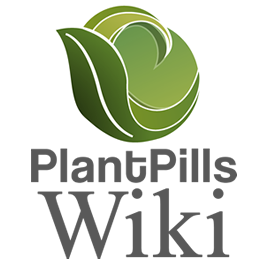
A photo of the PlantPills Raw Freeze Dried KAMUT® Wheatgrass Juice Powder. For more photos, please see the desktop version of this page here.
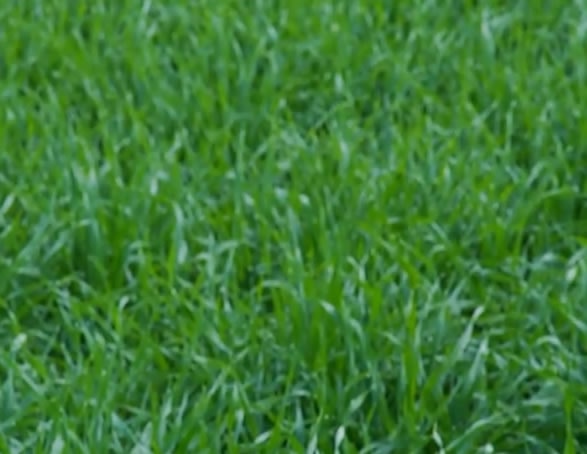
Wheatgrass is the first young green leaves that sprout from germinated wheat grains [1]. The grass leaves are harvested at the jointing stage, when the stem of the plant starts to form[2,3], because this is when the leaves are at their nutritional peak[4,5].
When grown in optimal conditions, wheatgrass contains most of the known vitamins and minerals [6], 297 proteins[7], over 80 active enzymes including the anti-oxidant and anti-ageing enzyme superoxide dismutase (SOD), fatty acids, immunomodulators, growth hormones, phytonutrients such as chlorophyll, carotenoids (including alpha-carotene, beta-carotene, xanthophylls, and zeaxanthin), bioflavonoids, growth factors, RNA and DNA, and a group of unclassified micro-nutrients simply referred to as grass juice factors[6].
Cows are able to effectively digest grass and make use of the nutrients, due to a part of their stomach called the rumen, where the cellulose-fermenting bacteria digest the cellulose [8]. Humans are unable to effectively digest raw grass, so some kind of processing must be carried out, in order for the nutrients to be assimilated.
The most widespread and popular method of processing wheatgrass is juicing, typically by cold-press or masticating juicers, or via triturating twin gear juicers [9]. This process crushes and squeezes the raw grass, with the liquid efficiently extracted from the dry pulp. The dry pulp mostly contains the non-nutritional cellulose fibre, which offers no vitamins or minerals and slows down the digestion. The liquid, referred to as wheatgrass juice, contains concentrated highly bio-available nutritients[10], and is retained and consumed.
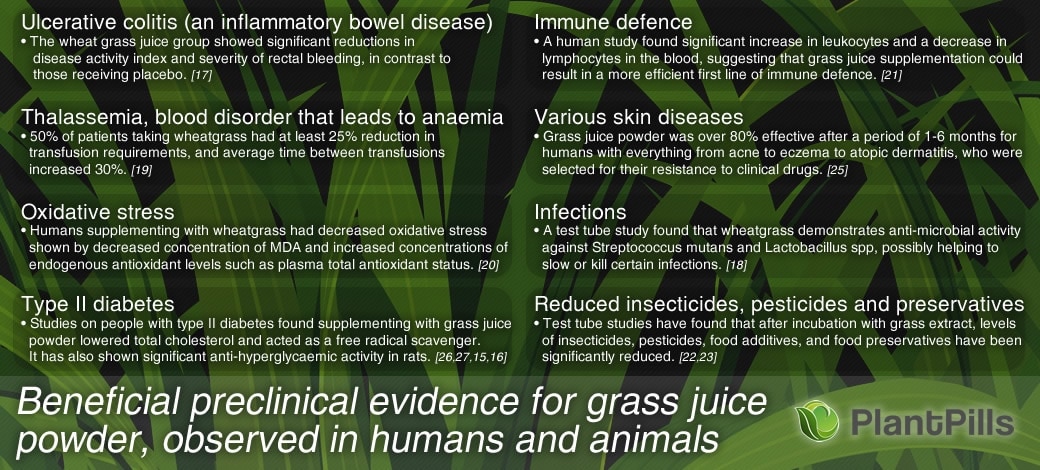
The first study acknowledging the high protein and low fibre content of “immature grasses” was in 1883, by the United States Department of Agriculture [11,12], and in 1890 it was discovered that the mineral content of grass peaked during its rapid growth stage, and declined as the plant matured[13].
These studies were both conducted in the context of feeding animals, and it wasn’t until 1930 that the possibility of incorporating grasses into the human diet was suggested by Charles Franklin Schnabel, an agricultural chemist.
After healing a flock of hens with young grass, he started to dry and powder young grasses and feed them to his family and neighbours.
Studies on chickens, turkeys, rats
[14], rabbits and guinea pigs were conducted in the 1930s, showing significant benefits of grass and grass juice, and the American Medical Association approved grass as a food.
One notable study on guinea pigs in 1939 by agricultural chemists at the University of Wisconsin concluded that “the growth stimulating factor of grass was distinct from all the known vitamins”
[35].
By 1940, cans of Schnabel’s dried grass were in pharmacies all over North America [6], and for his discoveries and establishing grass as a food and supplement, Schnabel is sometimes referred to as “The Father of Wheat Grass”.
In the 1950s, inspired by the positive effects of chewing on young wheatgrass, Ann Wigmore modified a meat grinder to become the first wheatgrass juicer.
She began delivering fresh raw wheatgrass juice to elderly and ill people in Boston (USA), before founding Hippocrates Health Institute (HHI) in 1958. HHI served over half a million glasses of wheatgrass juice in Boston by 1984
[33], and continues to serve fresh wheatgrass juice to its guests to this day. Researchers, ill people and celebrities visited her, raising the profile of raw wheatgrass juice and its beneficial effects[6].
In the 1970s, Yoshihide Hagiwara, a Japanese doctor, pharmacist, and inventor, set out on a mission to create a green fast-food. He believed that the juice of green vegetables was the finest source of nutrition, and after analysing 150 edible green plants, settled on young grass juice as the single source of the most remarkable quantities of active ingredients [6].
Hagiwara started producing grass juice powder, and developed a method of reducing the juice to powder at low temperature, after seeing reduced effects using conventional high temperature drying methods
[6].
His work stimulated studies and research into grass juice powder on animal and human health, and also pioneered methods of farming, harvesting and processing, that formed the foundations for modern day commercial grass juice powder manufacturing
[6].
It’s important to note that wheatgrass juice is a whole-food extract, not a drug, and we are not making any claims that wheatgrass can treat, cure or prevent any disease.
Wheatgrass juice and grass juice in general are relatively well studied in humans and animals. Studies have shown that wheatgrass juice, at the very least, is a safe and nutritious addition to the diet.
In a randomised double-blind placebo-controlled trial
[17], 23 human patients with active ulcerative colitis (an inflammatory bowel disease) were randomly grouped to receive either 100 mL (3.4oz) of wheat grass juice, or the same volume of placebo, daily for a month.
Disease activity index, bleeding faeces and number of bowel movements were all monitored, in addition to sigmoidoscopic evaluation, and global assessment.
The wheat grass juice group showed significant reductions in disease activity index and severity of rectal bleeding, in contrast to those receiving placebo.
No adverse effects of wheat grass juice were observed.
In a small study on 16 humans with the blood disorder thalassemia, that leads to anaemia, 100 mL (3.4oz) of wheat grass juice was consumed per day. 50% of patients had at least 25% reduction in transfusion requirements, average time between transfusions increased 30%, and no adverse side effects were reported. On the contrary, patients reported general well-being, improved appetite and reduced musculo-skeletal aches and pains [19].
A randomized, double-blind, placebo-controlled study conducted on healthy humans found that supplementation with wheatgrass powder (0.5g twice a day for 30 days) provided better protection against lipid peroxidation and thereby decreased oxidative stress as shown by a decreased concentration of MDA and increased concentrations of endogenous antioxidant levels such as plasma total antioxidant status and vitamin C, and improvement in activities of erythrocytes SOD
[20].
It’s also been found that wheatgrass juice powder has an antioxidant activity level comparable to ascorbic acid
[15]. Its antioxidant action is derived from its high content of bioflavonoids like apigenin, quercitin and luteolin.
Another study found that in addition to its free radical scavenging activity, wheatgrass juice powder contained phenols, flavonoids, tannins, alkaloids, steroids, sterols, saponins, coumarines, sugars, carbohydrates, polysaccharides, proteins, organic acids and fatty acids
[37].
A double blind human study found that supplementing with grass juice for 71 days found a significant increase in leukocytes and a decrease in lymphocytes in the blood, suggesting that grass juice supplementation could result in a more efficient first line of immune defence [21].
A long term human clinical trial in patients with various skin diseases (everything from acne to eczema to atopic dermatitis), who were selected for their resistance to clinical drugs, found that grass juice powder (4 grams, three times per day) was over 80% effective after a period of 1-6 months, with no side effects [25].
Two human studies on people with type II diabetes found that supplementing with grass juice powder (15 grams per day for 4 weeks) lowered total cholesterol and acted as a free radical scavenger
[26,27].
Studies performed on diabetic rats found that wheatgrass juice powder at a dosage of 0.1g per kg of body weight showed significant anti-hyperglycaemic activity
[15,16].
A study on mice fed grass juice powder as an addition to their food, found a significant increases in endurance and motor activity [24].
A test tube study found that wheatgrass demonstrates anti-microbial activity against Streptococcus mutans and Lactobacillus spp, possibly helping to slow or kill certain infections [18].
A test tube study found that after incubation with grass extract, the insecticide malathion was reduced by 81% in two hours, the food additive sorbic acid was reduced by 91% in 12 hours, and the food preservative BHT was reduced by 90% in 5 hours [22].
A similar test tube study found that after incubation with grass extract for three hours, levels of pesticides were significantly reduced; malathion and chlorpyrifos by 100%, parathion by 75%, diazinon by 54%, guthion by 41% and methidathion by 23%
[23].
This study also confirmed that when the grass extract is exposed to heat, the ability to detoxify or reduce the malathion level is lost.
Wheatgrass contains an oxidoreductase called peroxidase
[7], which is an enzyme that breaks down hydrogen peroxide, one of the toxins produced as a by-product of breathing oxygen[38]. In order for peroxidase to function, it requires NAD+ as a cofactor[39].
NAD+ levels naturally decline as we age
[40], and can be restored by supplementing with the NAD+ precursor, NMN. So it can be theorised that supplementing with NMN may help to get the most from wheatgrass.
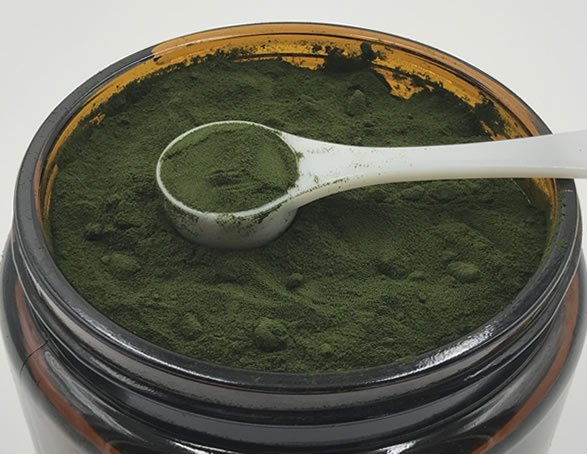
We believe that our wheatgrass juice powder is among the very best in the world, due to the species of wheat used, the growing conditions, the processing methods, our unique packaging that removes oxygen from the pack for at least 40 openings, and our third party lab testing for every batch.
Each batch of our wheatgrass is tested by third party laboratories, to ensure that there are no dangerous levels of heavy metals or micro-organisms. The certifications for the latest batch are viewable below.
We also periodically have third party lab tests completed for 69 pesticides and organic contaminants, carotenoids, zeaxanthin, calcium, copper, iron, magnesium, manganese, phosphorus, potassium, sodium, zinc, chlorophyll and superoxide dismutase (SOD).
All of these third party lab tests are viewable below.
Any retailer or producer of wheatgrass should be able to show you these tests from a third party laboratory. Without third party testing, it’s completely unknown whether the product is what it claims to be, and whether it’s safe for human consumption.
The full description of PlantPills wheatgrass is:
Raw Field Grown Freeze Dried KAMUT® khorasan Wheatgrass Juice Powder.
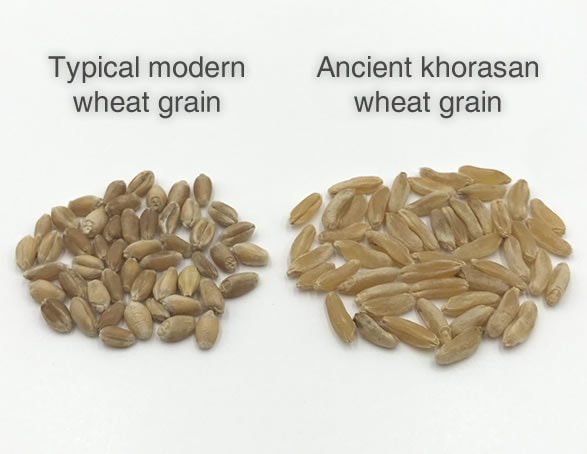 KAMUT® khorasan refers to the species of the wheat grain used, an ancient variety of wheat called khorasan. KAMUT® khorasan has never been hybridized or genetically modified, unlike modern wheat. The theory is that its retained many desirable qualities that have been lost or changed through the intensive breeding programs that have significantly altered modern wheat[28].
KAMUT® khorasan refers to the species of the wheat grain used, an ancient variety of wheat called khorasan. KAMUT® khorasan has never been hybridized or genetically modified, unlike modern wheat. The theory is that its retained many desirable qualities that have been lost or changed through the intensive breeding programs that have significantly altered modern wheat[28].
KAMUT® khorasan wheat is organically grown, and gram for gram has several nutritional advantages over modern wheat
[29], but crucially for our application growing high quality wheatgrass, each grain is 34% larger than standard wheat grain.
Studies have shown [30,31] that while good quality organic soil is important, a significant amount of nutrition in the grass comes from the initial nutrient base of the seed. With KAMUT® khorasan grain, the seed is 34% larger than standard wheat, with 34% more nutrients for the grass to utilise.
Field grown refers to the fact that our wheatgrass is grown outside, in organic soil, in fields on an organic farm. The wheatgrass grows at a natural rate for several months, before being harvested, as opposed to about 10 days for wheatgrass grown in trays, resulting in a much higher nutritional content[6].
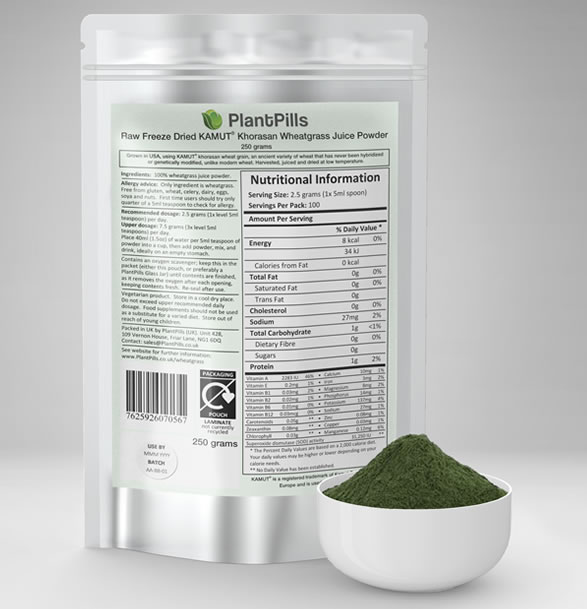
Juice powder means that this product is the solids of the juice of the wheatgrass.
Having been organically grown for several months outside in organic soil, our wheatgrass is harvested just before the critical jointing stage, where the grass is at peak nutrition.
It is immediately transported to the farm’s on-site juicing facility.
The juicing process crushes and squeezes the raw grass, with the liquid efficiently extracted from the dry pulp. The dry pulp mostly contains the non-nutritional cellulose fibre, which offers no vitamins or minerals and slows down the digestion. The liquid, referred to as wheatgrass juice, contains concentrated highly bio-available nutritients [10].
A modified freeze-drying method then removes all moisture from the freshly squeezed juice within a few minutes, leaving just the solids from the juice in the form of juice powder. These juice solids, known as wheatgrass juice powder, are vastly more nutritious than whole leaf wheatgrass powder[32].
Raw refers to the fact that from the harvest of the grass to the juicing of the grass, to removing the moisture from the juice, to the packaging of the juice powder, the material remains raw. It’s not heated above around 40°C (around 104°F). This is very important for the preservation of the active enzymes, vitamins, minerals and phytonutrients that are denatured or destroyed by heat.
When water is added to our wheatgrass juice powder, the resulting liquid is virtually identical to freshly squeezed wheatgrass juice, as the only processing that was done to the original juice was the removal of the water at low temperature. All the live enzymes, vitamins, minerals and phytonutrients remain active, due to avoiding exposure to heat, light and oxygen during processing, and being able to harvest, juice and powder on-site at the farm.
Although our wheatgrass is non-GMO, gluten free, herbicide and pesticide free, and grown and processed organically, PlantPills has not yet applied for organic certification in the UK, so we can not yet claim that our wheatgrass is organic, and do not sell it as organic.
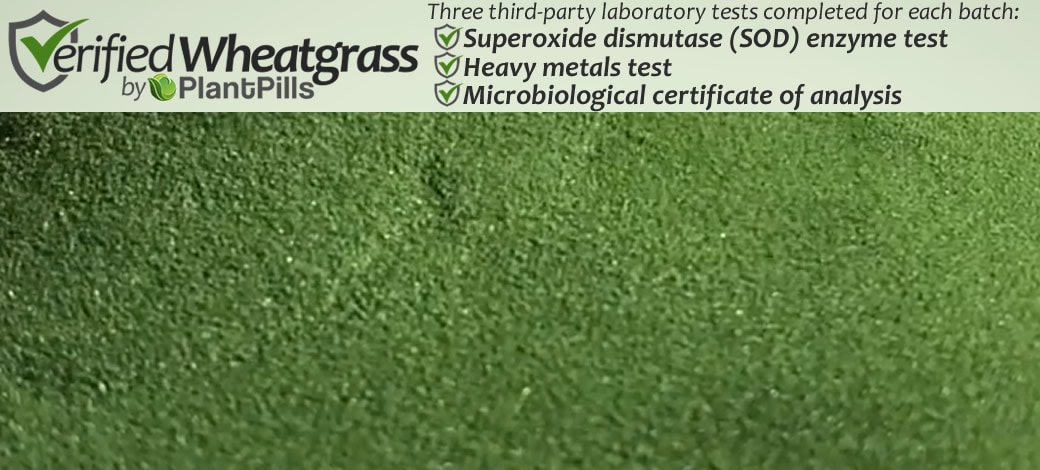
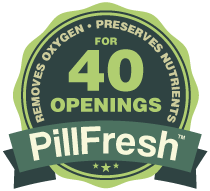 It is imperative that wheatgrass juice powder is transported and stored in an oxygen-free environment, even after opening. If wheatgrass juice powder is exposed to oxygen, the nutritional value quickly starts to diminish, because vitamins, enzymes and antioxidants are particularly sensitive to oxygen.
It is imperative that wheatgrass juice powder is transported and stored in an oxygen-free environment, even after opening. If wheatgrass juice powder is exposed to oxygen, the nutritional value quickly starts to diminish, because vitamins, enzymes and antioxidants are particularly sensitive to oxygen.
PlantPills wheatgrass juice powder is supplied in our unique PillFresh™ packaging, which keeps the powder sealed in an environment with an oxygen content of less than 0.1%. After you open your PlantPills wheatgrass juice powder, just seal it back up, and incredibly, our unique PillFresh™ packaging will again reduce the oxygen content to less than 0.1%, continuing to keep the wheatgrass juice powder fresh.
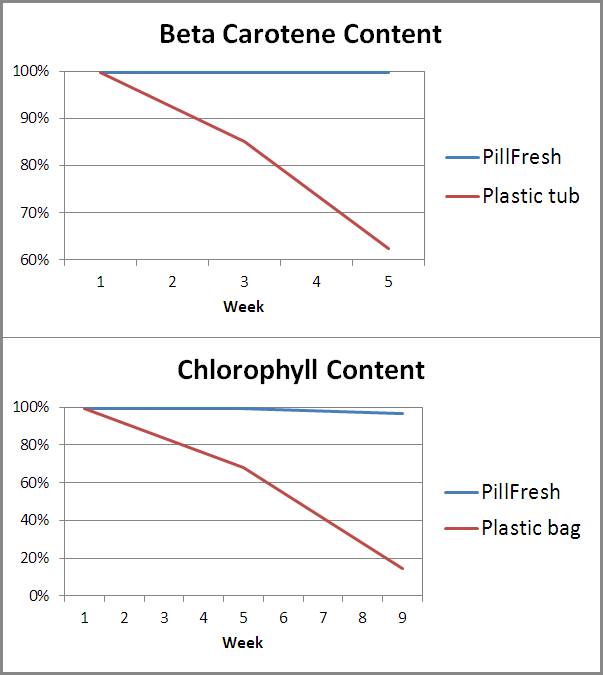
This packaging will continue to do this time and time again, for 40 openings.
Other vendors package wheatgrass powder in plastic tubs, or "vacuum sealed" aluminium pouches. Plastic tubs are permeable to oxygen, so are no use for keeping wheatgrass powder fresh. Powder in aluminium pouches are difficult to vacuum seal, and this type of vacuum sealing typically contains at least 2% oxygen. This is enough oxygen to start diminishing the nutritional value, and considering mould can grow in air with a 0.3% oxygen content, this really isn't acceptable.
It is therefore pretty certain that a significant amount of nutrition is lost before a typical package of wheatgrass is even opened by the consumer. Then, after opening, the exposure to oxygen quickly starts to diminish the nutritional value further. While our PillFresh packaging maintains 100% (or very close to 100%) of the nutrients, typical packaging will result in a 37% loss in beta carotene content after four weeks, and an 85% loss in chlorophyll content after 8 weeks.
PillFresh™ packaging is truly innovative, and exclusive to PlantPills.
There are a few different types of wheatgrass, or “wheat grass”. All are nutritionally beneficial, but there are pros and cons to each version.
Tray grown wheatgrass
This is commonly found in health food stores, retreats and juice bars. The wheatgrass is typically the Triticum aestivum variety, and is grown on trays, sometimes with soil and sometimes without.
It can be grown indoors or in warm sheltered outbuildings year-round, and takes around 10 days before the grass is ready for harvesting and juicing.
The benefits of growing wheatgrass in this manner include the ability to consume fresh wheatgrass juice immediately, and being able to do so year-round.
The drawbacks are the reduced nutritional content of the juice compared to that of wheatgrass grown outside in fields
[6], and the significant amount of time involved in growing and making it.
Estimated cost per 30ml/1oz shot: £0.08 (requiring 38g of grain, based on grain costing £2/kg).
Estimated cost per 30ml/1oz shot if using KAMUT® khorasan grain: £0.17 (requiring 51g of grain, based on grain costing £3.37/kg).
This estimated cost is just for the grain, and excludes water, soil, nutrients, and the significant amount of time spent preparing, growing, juicing and cleaning.
Field grown wheat grass powder (whole leaf powder)
This powder is commonly found in stores and online, and is called “wheatgrass powder”. It’s grown in fields, then cut, dehydrated and milled into powder. The end product is a whole-leaf wheatgrass powder. This includes the non-nutritional cellulose fibre that is discarded when juicing, so the price is lower than juice powder.
It is true to Charles Franklin Schnabel’s original preparations in the 1930s. Like all wheatgrass, it is still beneficial, but gram-for-gram its less nutritious than juice powder
[6].
Field grown wheat grass juice powder
Wheat grass that is grown outside in fields, then harvested and juiced before having the moisture removed, is called “field grown wheat grass juice powder”.
The wheat grass spends a few months naturally maturing to the point of maximum nutrition, compared to the 10 days it takes for indoor/tray grown wheatgrass to reach this stage. This gives the roots the opportunity to reach 15-30cm (6-12”) down, and obtain maximum nutrients from deep within the soil. The result is a more nutritious grass compared to indoor/tray grown wheatgrass, with 4-10 times the chlorophyll content alone
[6].
Manufacturing field grown wheat grass juice powder is relatively difficult, especially when growing the wheat grass organically, trying to obtain maximum nutrition, quickly harvesting, juicing and drying, ensuring the resulting product is free from 69 pesticide and non-organic contaminants, keeping heavy metals to a minimum, avoiding exposure to light and oxygen in processing, juicing the grass and drying the juice at low temperature, and keeping microbial content low.
In addition to being raw, field grown, and freeze dried, our wheatgrass juice powder is grown from an ancient heirloom, more nutritious khorasan variety of wheat called KAMUT® khorasan. KAMUT® khorasan grain is much larger modern wheat, and has never been hybridized or genetically modified, unlike modern wheat.
Estimated cost per 30ml/1oz shot: £0.22 (1.8 grams of PlantPills Wheatgrass Juice Powder is equivelant to the solids from 30ml of fresh wheatgrass juice, cost based on a 250g packet costing £30).
This is remarkable value for money, considering that the KAMUT® khorasan grain alone would cost £0.17 (30ml of juice requires around 51g of KAMUT® khorasan grain, based on grain costing £3.37/kg).
It is sensible for anyone who is new to taking wheatgrass, to initially take just a quarter of one 5ml teaspoon spoon (about 0.6 grams) and monitor themselves for any adverse reactions for 24 hours. If there is no reaction, proceed with supplementation the following day.
One 250g pack of PlantPills Wheatgrass Juice Powder contains the solids of 4.1 litres of wheatgrass juice (1.1 US gallon).
4.1 litres (1.1 US gallon) was extracted from 5.3 kilograms of fresh raw KAMUT® khorasan wheatgrass (11.7 lb).
5.3 kilograms of grass is roughly equivalent to 12 trays of wheatgrass (each tray measuring 40x28cm or 16x11”).
One 250g pack of PlantPills Wheatgrass Juice Powder contains the equivalent of 138 shots (30ml or 1oz) of wheatgrass, with 1.8 grams of PlantPills Wheatgrass Juice Powder equivalent to one 30ml/1oz shot of wheatgrass.
One 5ml teaspoon is roughly 2.5 grams of powder, extracted from 41ml of juice (1.4 x 30ml/1oz shots).
Two 5ml teaspoons is roughly 5 grams of powder, extracted from 82ml of juice (2.8 x 30ml/1oz shots).
Three 5ml teaspoons is roughly 7.5 grams of powder, extracted from 124ml of juice (4.1 x 30ml/1oz shots).
Ann Wigmore specified that “1 to 4 ounces at a time will do”
[33], this is equivalent to 1-3 teaspoons of PlantPills wheatgrass juice powder.
Directions: Mix into liquid before drinking, ideally on an empty stomach.
The most traditional way of consuming wheatgrass juice is via a “shot”. To administer via this method, first add water to a cup, and then place the powder onto the water, and mix.
40ml (about 1.5oz) of water should be added to the cup for every 5ml teaspoon of powder. Then use a fork to mix the powder into the water (about 100 revolutions in each direction), before drinking.
As with other powders (such as milkshake powder, hot chocolate powder, etc.) there may be some clumps of powder. These can be reduced with thorough mixing, but are perfectly fine. Consume immediately after mixing.
When drinking the wheatgrass juice, it is best to hold some in the mouth for a while. Spread it around the mouth, including on the cheeks and under the tongue, holding the contents in the mouth for a minute or so, like a mouthwash, before swallowing.
This route of administration is called buccal and sublingual, and provides highly efficient absorption of some of the molecules within wheatgrass juice. Some of the absorption is provided via the blood vessels under the tongue, bypassing the digestive tract, and can result in a much more efficient absorption rate, depending on the molecule[34]. Wheatgrass juice has an intense flavour, so this may be difficult or impossible for some people.
For people particularly adverse to the taste of wheatgrass, it is common to add the wheatgrass powder to a smoothie or other drink, in order to comfortably consume. A blender can cause significant degradation via oxygenation to the wheatgrass, so gentle manual mixing is preferred. Consume immediately after mixing.
Recommended dosage: 2.5 grams (1x level 5ml teaspoon) per day.
Upper dosage: 7.5 grams (3x level 5ml teaspoons) per day. Ideally should be taken first thing in the morning on an empty stomach. Can be taken all at once, or split up throughout the day.
Note: Although wheatgrass is rich in certain nutrients, it is the presence of the vast array of vitamins, minerals, enzymes, phytonutrients and grass juice factors, and not necessarily the nutritional content, that makes wheatgrass unique. Wheatgrass juice powder should be regarded as a natural nutritional supplement, rather than a primary source of nutrition.
Note: It may be beneficial to take one or two days off per week from supplementing with wheatgrass juice powder.
Ann Wigmore took wheatgrass juice on a daily basis for more than 30 years
[33], and there is no evidence to suggest that having days off is beneficial, but the body can respond positively when given periodic breaks from routine.
Note: Scientists have never found wheatgrass to be toxic in any amount when given to either animals or humans[33].
Note: Other uses for wheatgrass juice include mixing the powder into a relatively small amount of water to make a paste, and apply topically to the skin. It may be applied all-over as a general tonic, or to specific areas of interest, before being washed off after a while[33].
It has been speculated that adding wheatgrass to bathing water may be beneficial
[33].
Wheatgrass is gluten free[36], because the grass of the grain, rather than the grain itself is used. However, there is the possibility of contamination, and some wheatgrass powders do contain gluten.
PlantPills Wheatgrass Juice Powder is gluten free, and each batch is tested to confirm gluten free status.
If you are taking prescription medication, consult your doctor before use.
Re-seal packet after use and store in a cool dry place. Ambient temperature of the storage area should be below 25° Celsius (77° Fahrenheit). If the ambient storage temperature exceeds this, it should be stored in a refrigerator.
Keep contents in the packet or in a PlantPills Glass Jar until contents are finished. PlantPills Glass Jars are available for purchase in the shopping basket.
Please see the label from our 250 gram pack of Raw Field Grown Freeze Dried KAMUT® khorasan Wheatgrass Juice Powder below.
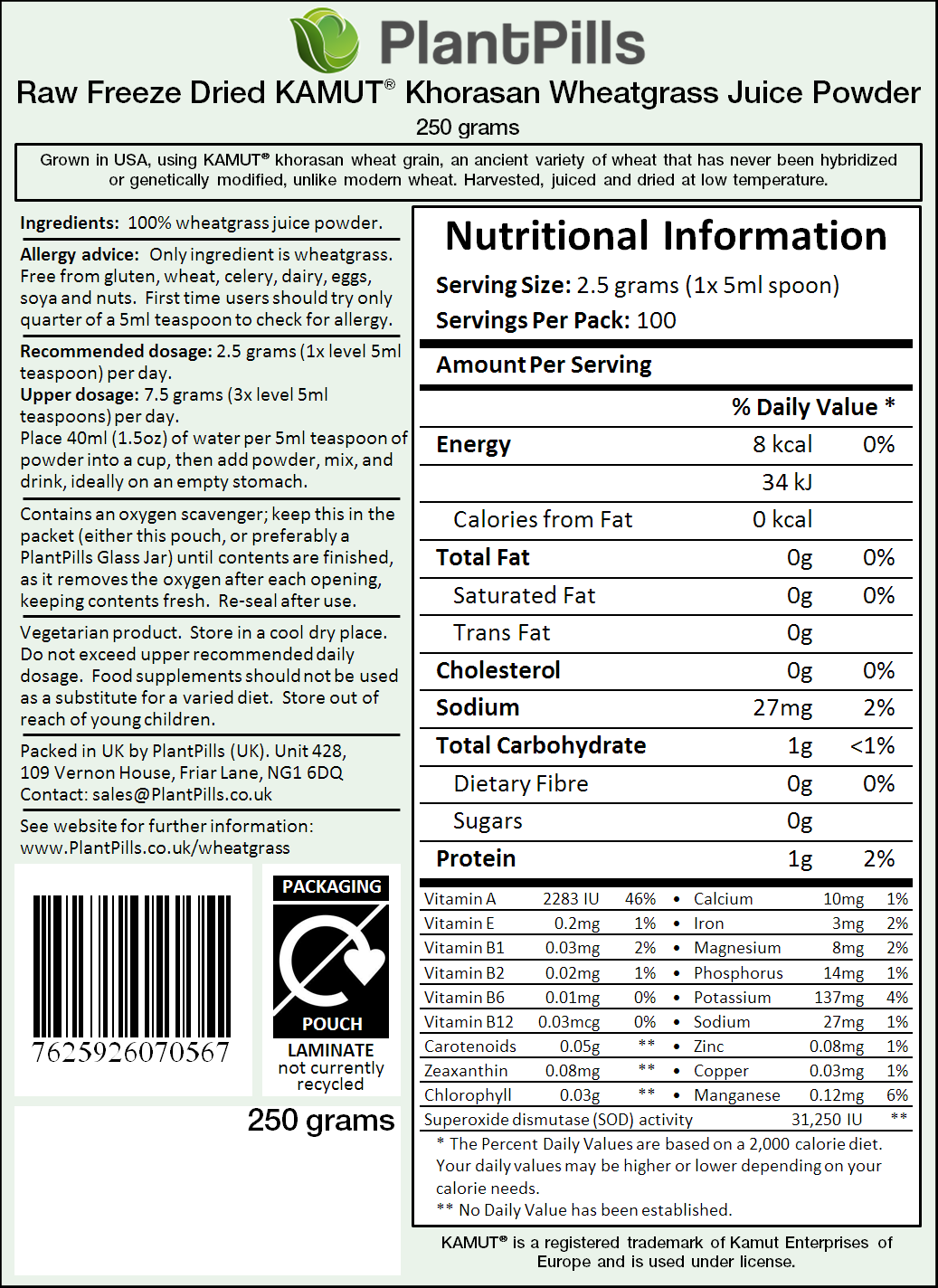
Wheatgrass juice is safe, widely consumed, and has no known toxic dose[33].
Some people may experience detox symptoms when first taking wheatgrass juice.
A quarter of one 5ml teaspoon spoon (about 0.60 grams) should be taken when first starting to supplement with wheatgrass, to monitor for any possible allergy or intolerance.
Symptoms of allergy or intolerance include severe headache, throat swelling, nausea or digestive discomfort. Please seek emergency medical care if you experience any of these symptoms in a severe form.
Persons taking the blood-thinning drug known as Coumadin (generic warfarin) are advised to completely avoid wheatgrass, or use caution and follow the advice of their healthcare professional, because wheat grass contains vitamin K, which may affect the inhibition of blood clots.
Wheatgrass contains B vitamins which are linked to increased energy. Some people may experience difficulty in sleeping if taking a large dose of wheatgrass just before bed.
It is easier on the digestive system to take wheatgrass separately from milk or other dairy products such as yoghurt or cheese.
People who are allergic to other grasses may also be allergic to wheatgrass.
People with plant allergies should consult a doctor before trying wheatgrass.
It is never advisable to start taking a new food supplement such as wheatgrass during pregnancy.
If you are taking prescription medication, consult your doctor before use.
Food supplements should not be used as a substitute for a varied diet.
KAMUT® is a registered trademark of Kamut Enterprises of Europe and is used under license.
Please find all sources and references listed below. Archived versions are included in the event that the original material is changed, moved or removed. Please note that none of these sources are affiliated with PlantPills.
| 1 |
Wheatgrass, [mirror] From Wikipedia, the free encyclopedia 2019 |
| 2 |
NMSU: Small Grain Silages for New Mexico, [mirror] Mark A. Marsalis Circular 630, College of Agricultural, Consumer and Environmental Sciences, New Mexico State University. |
| 3 |
Spring wheat growth and development guide, [mirror] Phyllis Bongard, Extension communications specialist; Erv Oelke, emeritus Extension agronomist and Steve Simmons, emeritus agronomist, College of Food, Agricultural and Natural Resource Sciences University of Minnesota Extension, Reviewed in 2018 |
| 4 |
Wheatgrass Juice and its Nutritional Value as Affected by Sprouting Condition, [mirror] Dina.A.Anwar, A.Abou El-Yazied, Thanaa.F.Mohammadi and M.M.F.Abdallah Horticulture Department, Faculty of Agriculture, Ain Shams University, Cairo, Egypt, and Regional Center for Food and Feed, Agri.Res.Center, Giza, Egypt. May 2015. DOI: 10.21608/ajs.2015.14558 |
| 5 |
Determination of Minerals and Antioxidant Activities at Different Levels of Jointing Stage in Juice of Wheat Grass -The Green Wonder, [mirror] Anu Agrawal, Ena Gupta and Reena Chaturvedi International journal of pure & applied bioscience, 3 (2): 311-316 (2015). ISSN: 2320 – 7051 |
| 6 |
Wheatgrass Nature's Finest Medicine: The Complete Guide to Using Grass Foods & Juices to Revitalize Your Health (6th ed.)
Steve Meyerowitz Book Publishing Company. p. 53. ISBN 978-1-878736-97-0, April 1999 |
| 7 |
Nutritional Quality and Antioxidant Activity of Wheatgrass (Triticum aestivum) Unwrap by Proteome Profiling and DPPH and FRAP assays, [mirror] Parit SB, Dawkar VV, Tanpure RS, Pai SR, Chougale AD J Food Sci. 2018 Aug;83(8):2127-2139. doi: 10.1111/1750-3841.14224. Epub 2018 Jul 30. PubMed PMID: 30059150. |
| 8 |
Exploring Cow Digestion, [mirror] Adam I. Orr U.S. Food & Drug Administration, 2017 |
| 9 |
Juicer - Masticating juicers, [mirror] From Wikipedia, the free encyclopedia 2019 |
| 10 |
Evaluation of bioaccessibility of some essential elements from wheatgrass (Triticum aestivum L.) by in vitro digestion method, [mirror] S.D.Kulkarni, R.Acharya, N.S.Rajurkar, A.V.R.Reddy Food Chemistry. Volume 103, Issue 2, 2007, Pages 681-688. https://doi.org/10.1016/j.foodchem.2006.07.057 |
| 11 |
Grasses as a feeding value for milk production, [mirror] R. R. Graves, J. R. Dawson, D. V. Kopland, T. W. Moseley U.S. Dept. of Agriculture, Technical bulletin no. 381, August 1933 |
| 12 |
Grasses
Richardson, C. U.S. Dept. Agr. Ann. Rpt. 1883: 231-233. |
| 13 |
Second Annual Report
Morse, F.W. The Department of Agriculture state of New Hampshire, 1890 |
| 14 |
GROWTH STIMULATING PROPERTIES OF GRASS JUICE, [mirror] G. O. Kohler, C. A. Elvehjem, E. B. Hart Science 08 May 1936: Vol. 83, Issue 2158, pp. 445 DOI: 10.1126/science.83.2158.445 |
| 15 |
Phytochemical and Pharmacological Screening of Wheatgrass Juice (Triticum Aestivum L.), [mirror] Shirude Anup Ashok Int. J. Pharm. Sci. Rev. Res. 2011, 9, 159–164 |
| 16 |
Antidiabetic and Antioxidant Properties of Triticum aestivum in Streptozotocin-Induced Diabetic Rats, [mirror] Mohan Y, Jesuthankaraj GN, Ramasamy Thangavelu N. Adv Pharmacol Sci. 2013;2013:716073. doi:10.1155/2013/716073 |
| 17 |
Wheat grass juice in the treatment of active distal ulcerative colitis: a randomized double-blind placebo-controlled trial., [mirror] Ben-Arye E, Goldin E, Wengrower D, Stamper A, Kohn R, Berry E. Scand J Gastroenterol. 2002 Apr;37(4):444-9. PMID: 11989836 |
| 18 |
Evaluation of the anti-microbial activity of various concentration of wheat grass (Triticum aestivum) extract against Gram-positive bacteria: An in vitro study, [mirror] Rajpurohit Ladusingh, Mehta Nishant, Ankola Anil V, Gadiyar Akshata Journal of Dental Research and Review, 2015, Volume: 2, Issue Number: 2, Page: 70-72 |
| 19 |
Wheat grass juice reduces transfusion requirement in patients with thalassemia major: A pilot study, [mirror] Marwaha RK, Bansal D, Kaur S, Trehan A. Indian Pediatrics, 2004; 41: 716-720 |
| 20 |
Wheat grass supplementation decreases oxidative stress in healthy subjects: a comparative study with spirulina., [mirror] Shyam R, Singh SN, Vats P, Singh VK, Bajaj R, Singh SB, Banerjee PK. J Altern Complement Med. 2007 Oct;13(8):789-91. PMID: 17983333 DOI: 10.1089/acm.2007.7137 |
| 21 |
Immune System Components Altered by a Food Supplement. Wagner ES, Mocharla R. Annual Meeting of the American Association for the Advancement of Science February (Vol. 16, p. 1991) |
| 22 |
Effect on the Several Food Additives, Agricultural Chemicals and a Carcinogen
Y. Hagiwara, M.D. Presented to the 98th Annual Assembly of Pharmaceutical Society of Japan, April 5, 1978 |
| 23 |
Degradation of organophosphorus pesticides in aqueous extracts of young green barley leaves (Hordeum vulgare L).
Durham, J., Ogata, J., Nakajima, S., Hagiwara, Y., and Shibamoto, T 1999, J. of the Science of Food and Agriculture Vol 79 (10) pp 1311–1314 |
| 24 |
Studies on the Effects of Green Barley Juice on the Endurance and Motor Activity in Mice
K. Kubota and N. Sunagane Faculty of Pharmaceutical Sciences, Science Univ. Of Tokyo, Japan. Presented Before the 104th Annual Congress of Pharmaceutical Society of Japan, Sendai, 1984 |
| 25 |
Therapeutic Experiment of Young Green Barley Juice for the Treatment of Skin Diseases in the Main
Tatsuo Muto, Muto Dermatologic Hospital New Drugs and Clinical Application. Vol. 26, No. 5. May 10, 1977 |
| 26 |
Effect of Young Barley Leaf Extract and Antioxidative Vitamins on Ldl Oxidation and Free Radical Scavenging Activities in Type 2 Diabetes
Ya-Mei Yu, Weng-Cheng Chang, Chwen-Tzuei Chang, Ching-Liang Hsieh, Chingmin E, Tsai Diabetes Meta 2002; 28(2): 107-14. (SCI) |
| 27 |
Ldl Cholesterol and Oxidation Are Significantly Reduced in Type 2 Diabetic Patients Receiving a Barley Leaf Essence Supplemented Olive Oil Diet
Yu YM, Tsai CE Food Science and Agricultural Chemistry [published by The Chinese Institute of Food Science and Technology] Vol. 5 (1): 1-6 (2003) |
| 28 |
The Grain - KAMUT® Khorasan Wheat, [mirror] Kamut International, Ltd. & Kamut Enterprises of Europe bvba 2019 |
| 29 |
Nutritional Comparison: Wheat, hard red winter vs Kamut, uncooked, [mirror] The Nutrition Search Engine - SkipThePie.org 2019 |
| 30 |
Evaluation of the antioxidant activity of wheatgrass (Triticum aestivum L.) as a function of growth under different conditions., [mirror] Kulkarni SD, Tilak JC, Acharya R, Rajurkar NS, Devasagayam TP, Reddy AV Phytother Res. 2006 Mar;20(3):218-27. PMID: 16521113 |
| 31 |
Determination of elemental concentration profiles in tender wheatgrass (Triticum aestivum L.) using instrumental neutron activation analysis, [mirror] S.D.Kulkarni, R.Acharya, A.G.C.Nair, N.S.Rajurkar, A.V.R.Reddy Food Chemistry, Volume 95, Issue 4, April 2006, Pages 699-707 |
| 32 |
Juice Powder Vs Plant Powder: What to Use in Your Supplement Formula?, [mirror] Melissa DellaBartolomea NutraScience Labs, April 15th, 2016 |
| 33 |
Thewheatgrass book: How to grow and use wheatgrass to maximize yourhealth and vitality Ann Wigmore 1985 |
| 34 |
SUBLINGUAL MUCOSA AS A ROUTE FOR SYSTEMIC DRUG DELIVERY (PDF), [mirror] NEHA NARANG, JYOTI SHARMA International Journal of Pharmacy and Pharmaceutical Sciences ISSN- 0975-1491 Vol 3, Suppl 2, 2011 |
| 35 |
The Relation of the Grass JuiceFactor to Guinea Pig Nutrition
G.O. Kohler, C.A. Elvehjem, and E.B. Hart Department of Agriculture Chemistry, University of Wisconsin, Madison, Pub November 24, 1937 in the Journal of Nutrition, Vol.15, p. 445. No.5. Also, The Grass Juice Factor, by G. Kohler, S. Randle, and J. Wagner. Journal of Biology and Chemistry. V.128. 1939. |
| 36 |
Confirmation of gluten-free status of wheatgrass (Triticum aestivum), [mirror] S.L. Adrianos, B. Mattioni, M. Tilley Quality Assurance and Safety of Crops & Foods, Volume 9, Number 1, 1 January 2017, pp. 123-128(6), DOI: https://doi.org/10.3920/QAS2015.0764 |
| 37 |
Non-Enzymatic Assay Based in-vitro Antioxidant Activity and Phytochemical Screening of Freeze Dried Wheat (Triticum Aestivum L.) Seedlings Juice Powder: Nature’s Finest Medicine-Part-II, [mirror] H. S. Dhaliwal, N. Sharma, A. Bano, S. Kumar and V. Sharma Int J Pharm Sci Res 2015; 6(9): 4036-46. doi: 10.13040/IJPSR.0975-8232.6(9).4036-46. |
| 38 |
Enzymes, [mirror] Dr. Maggie Whitson Northern Kentucky University, Biological Sciences Department |
| 39 |
Oxidoreductase, [mirror] From Wikipedia, the free encyclopedia 2019 |
| 40 |
Slowing ageing by design: the rise of NAD+ and sirtuin-activating compounds., [mirror] Bonkowski MS, Sinclair DA. Nat Rev Mol Cell Biol. 2016 Nov;17(11):679-690. doi: 10.1038/nrm.2016.93. Epub 2016 Aug 24. Review. |

To purchase the PlantPills Raw Freeze Dried KAMUT® Wheatgrass Juice Powder, please see the desktop version of this page here.
